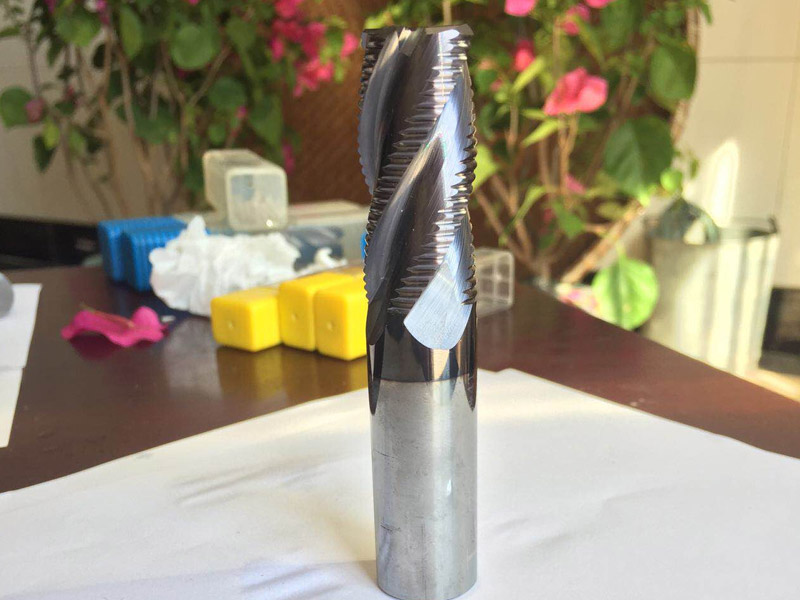
Rough milling cutter: efficient roughing tool
In the broad field of machining, milling cutter, as a key cutting tool, undertakes the important mission of shaping the shape of the workpiece. Today, we want to give you a detailed introduction to a rough milling cutter that performs particularly well in the roughing stage, which is famous for large cutting amount, poor cutting and high processing efficiency, known as "violent milling". Whether it is an experienced processing master or a friend who comes into contact with you for the first time, you can benefit from its unique properties.
First, the difference between rough milling cutter and ordinary milling cutter
Tool design
1. Tooth shape and cutting edge :
The shape of the teeth and the design of the cutting edge of the rough milling cutter are exceptional. It has a wide and deep cutting edge, like a sharp dagger, which can easily cut into the workpiece and withstand huge cutting forces. This design makes it easy to rough machining with large feed and large cutting depth. Moreover, the tooth spacing is large, which provides a smooth channel for the rapid discharge of chips, avoids the blockage of chips, and ensures the continuity of processing.
The tooth shape of the ordinary milling cutter is relatively fine, and the cutting edge is narrow, which is suitable for cutting with general precision requirements, such as semi-finishing and finishing, focusing on the precision of cutting and the smoothness of the surface.
2. Tool structure :
The overall structure of the rough milling cutter is more solid, like a solid fortress, which can resist the high load impact during roughing. It may use a larger handle diameter and thicker blade, improve the rigidity of the tool, reduce the vibration and deformation under the action of large cutting forces, and ensure the stability of the processing.
Ordinary milling cutter pays more attention to cutting accuracy and surface quality, the structure is relatively light, higher flexibility, suitable for processing occasions with higher dimensional accuracy and surface roughness requirements.
Processing purposes
1. Processing stage :
Rough milling cutter is mainly used in the roughing stage of the workpiece, like a powerful pioneer officer, quickly remove a large amount of material, paving the way for subsequent finishing, leaving a small processing margin, greatly shortening the time of the entire processing process.
Ordinary milling cutters are more used in semi-finishing and finishing stages, like a fine craftsman, to carve the workpiece to obtain higher dimensional accuracy and surface quality, to meet the precise assembly requirements of mechanical parts.
2. Applicable material :
The rough milling cutter is suitable for materials with relatively low hardness and large processing allowance, such as cast iron and aluminum alloy. For these materials, the rough milling cutter can exert its powerful cutting ability to quickly remove excess parts. For some difficult to process materials, rough milling cutter can also improve cutting performance through special materials and coatings to overcome processing problems.
Ordinary milling cutters have a wider range of applications, including materials with higher hardness. When processing high-hardness materials, as long as the appropriate tool material and cutting parameters are selected, the ordinary milling cutter can also be competent to ensure the smooth cutting and the quality of the workpiece.
Cutting parameters
1. Cutting depth and feed rate :
Rough milling cutters show great ability in terms of cutting depth and feed. It can use a larger cutting depth, up to a few millimeters or even more than ten millimeters, and the feed speed can also be higher, thus significantly improving the processing efficiency. This aggressive cutting method enables it to complete a large number of material removal tasks in a short time.
Ordinary milling cutter is relatively cautious, the cutting depth and feed amount is small, the general cutting depth is below a few millimeters, the feed speed is moderate, to ensure processing accuracy and surface quality, suitable for fine cutting.
2. Cutting speed :
The cutting speed of the rough milling cutter is relatively low. This is due to the different tool structure and processing requirements, the lower cutting speed helps to reduce tool wear, extend the tool life, while ensuring the processing stability under the large cutting force, to avoid the tool damage and workpiece quality decline caused by too fast speed.
Ordinary milling cutters can use higher cutting speeds to obtain better surface quality and processing efficiency. However, the choice of cutting speed also needs to be reasonably adjusted according to the tool material, workpiece material and processing requirements to ensure the smooth progress of the cutting process and the quality of the workpiece.
Processing effect
1. Surface quality :
The surface of rough milling cutter is relatively rough, leaving a large processing allowance. However, this "extensive" processing method provides a good foundation for subsequent finishing, reducing the time and tool wear of finishing, and improving the efficiency of the entire processing process.
Ordinary milling cutter can obtain higher surface quality, smaller surface roughness, suitable for workpiece processing with higher surface quality requirements, such as the final surface of mechanical parts, to ensure that it has good performance and appearance during use.
2. Dimensional accuracy :
The dimensional accuracy of the rough milling cutter is relatively low, which is mainly used to remove a large amount of materials, and the control requirements for the dimensional accuracy are not high, but it can meet the basic needs of the roughing stage.
Ordinary milling cutter can achieve higher dimensional accuracy to meet the requirements of precision machining, such as the matching size of mechanical parts, to ensure its accuracy and reliability in assembly and use.
Second, the use of coarse milling cutter and ordinary milling cutter
The use of coarse leather milling cutter
1. Blank processing :
When processing castings, forgings and other rough parts, because there is usually a large amount of margin and uneven surface, rough milling cutter can show its skill. Like a brave pioneer, it quickly removes these excess materials to provide a more flat surface for subsequent processing.
For example, in the machining workshop, when conducting preliminary processing of large cast iron parts, the rough skin milling cutter can efficiently remove the casting skin and large margin, improve processing efficiency, reduce processing costs, and lay a good foundation for subsequent finishing.
2. Large margin cutting :
In some processing scenarios where a large amount of material needs to be removed, such as the roughing stage in mold manufacturing, the roughing cutter can be processed with a large cutting depth and feed speed, giving play to its advantages of efficient material removal.
For example, when manufacturing plastic injection molds, the rough milling cutter is first used to rough the steel blank, quickly remove most of the margin, save time for subsequent semi-finishing and finishing, improve the overall efficiency of mold manufacturing, and reduce production costs.
3. Low precision processing :
For some machining tasks that do not require high dimensional accuracy and surface quality, rough milling cutters are a cost-effective option that can quickly complete processing tasks and reduce processing costs.
For example, in the construction industry, the simple roughing of some metal components to meet the basic shape and size requirements, at this time, the use of rough milling cutter can quickly complete the task, improve production efficiency, to meet the rapid construction needs of the construction industry.
4. Material hardness is low processing :
For relatively soft materials such as aluminum alloy and copper, rough milling cutters can reduce tool wear and improve tool life while ensuring processing efficiency.
In the manufacture of electronic equipment, when the aluminum alloy shell is roughed, the rough milling cutter can quickly remove the material, prepare for the subsequent fine processing, and ensure the rapid production and stable quality of electronic equipment parts.

Common milling cutter use scenario
1. Semi-finishing and finishing :
In the semi-finishing and finishing stages of parts processing, ordinary milling cutters can provide higher dimensional accuracy and surface quality to meet the precise assembly requirements of mechanical parts.
For example, in the automotive engine manufacturing, when the engine cylinder block, cylinder head and other key parts are semi-finished and finished, it is necessary to use an ordinary milling cutter to ensure the dimensional accuracy and surface finish of the parts to meet the high-performance requirements of the engine and ensure the smooth operation and reliability of the engine.
2. Small residual cutting :
When the machining allowance is small and fine cutting is required, the ordinary milling cutter can better control the cutting parameters, achieve high-precision machining, and ensure the dimensional accuracy and surface quality of the workpiece.
For example, in precision instrument manufacturing, when processing some small-size parts, the ordinary milling cutter can be precisely cut with a small cutting depth and feed speed to ensure the dimensional accuracy and surface quality of the parts, and meet the high-precision requirements of precision instruments for parts.
3. High hardness material processing :
For materials with higher hardness, such as hardened steel, cemented carbide, etc., ordinary milling cutters can use special tool materials and coatings to achieve effective cutting and ensure the service life and processing quality of the tool.
In mold manufacturing, when processing heat-treated die steel, it is necessary to use high-performance ordinary milling cutters to ensure processing quality and tool life, and meet the high precision and high durability requirements of the mold.
4. Complex shape processing :
When machining parts with complex shapes, ordinary milling cutters can achieve precise machining through different cutting methods and tool paths to ensure the accuracy and quality of the parts.
For example, in the aerospace field, when processing aircraft parts, ordinary milling cutters can be programmed according to the complex shape of the parts to ensure the accuracy and quality of the parts, and meet the aerospace requirements for high reliability and high precision of parts.
In short, the rough milling cutter and the ordinary milling cutter each perform their duties in the machining and play an irreplaceable role. With its strong roughing ability, the rough milling cutter provides an efficient solution for machining. The ordinary milling cutter ensures the high precision and high quality of the mechanical parts with its fine processing performance. Understanding and mastering their characteristics and application scenarios, reasonable selection of the appropriate milling cutter, is the key for every mechanical processor to improve processing efficiency and quality.



